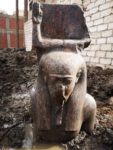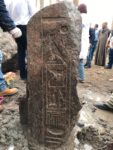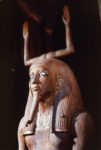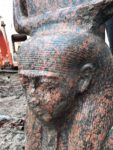 A unique statue of Ramesses II adorned with the “ka” sign has been discovered. The ka was the life-force of an individual, the key spirit of a person that continued the live after physical death. It was the ka, entombed with the body it once inhabited, which ate the food offerings and dwelled in the ka statue to keep itself (and therefore the deceased) eternally alive. The only other ka statue of a pharaoh that has been found is the life-sized wooden statue of the 13th Dynasty pharaoh Hor (ca. 1750 B.C.), discovered in the pharaoh’s tomb in 1894 and considered an artistic masterpiece of the period.
A unique statue of Ramesses II adorned with the “ka” sign has been discovered. The ka was the life-force of an individual, the key spirit of a person that continued the live after physical death. It was the ka, entombed with the body it once inhabited, which ate the food offerings and dwelled in the ka statue to keep itself (and therefore the deceased) eternally alive. The only other ka statue of a pharaoh that has been found is the life-sized wooden statue of the 13th Dynasty pharaoh Hor (ca. 1750 B.C.), discovered in the pharaoh’s tomb in 1894 and considered an artistic masterpiece of the period.
The statue was found on private property in the town of Mit Rahina near the temple of the god Ptah in ancient Memphis. A 62-year-old man excavated under his house and came across large blocks of stone immersed in the ground water. Unauthorized excavation is illegal in Egypt due to the potential for damage to archaeological material and the risk of artifact trafficking. Police busted him earlier this month and Ministry of Antiquities archaeologists began a salvage excavation.
 The team unearthed the top half of a rose granite statue of 19th Dynasty pharaoh Ramesses II (r. 1279–1213 B.C.). The statue is 1’10” wide and just shy of 3’5″ high and depicts the pharaoh wearing a tripartite hair wig with the symbol for “ka” (two upraised arms connected in the middle forming a u-shape) over his head. On the back pillar is the hieroglyphic inscription “Ka Nakht Mari Maat,” literally “The Powerful Loved Bull Maat”. Ramesses’ regnal name was Usermaatre Setepenre, meaning “The Maat of Ra is powerful, Chosen of Ra.” (The Greek name for Ramesses, Ozymandias, of Shelley look-on-my-works-ye-mighty-and-despair fame, is derivation of Usermaatre.)
The team unearthed the top half of a rose granite statue of 19th Dynasty pharaoh Ramesses II (r. 1279–1213 B.C.). The statue is 1’10” wide and just shy of 3’5″ high and depicts the pharaoh wearing a tripartite hair wig with the symbol for “ka” (two upraised arms connected in the middle forming a u-shape) over his head. On the back pillar is the hieroglyphic inscription “Ka Nakht Mari Maat,” literally “The Powerful Loved Bull Maat”. Ramesses’ regnal name was Usermaatre Setepenre, meaning “The Maat of Ra is powerful, Chosen of Ra.” (The Greek name for Ramesses, Ozymandias, of Shelley look-on-my-works-ye-mighty-and-despair fame, is derivation of Usermaatre.)
 The blocks of stone were the remains of a temple to Ptah, patron deity of the ancient capital of Memphis. In addition to the statue, 19 blocks of rose granite and limestone engraved with dedications to Ptah, cartouches of Ramesses II and depictions of the pharaoh engaged in the Heb Sed ceremony, a ritual celebrated when a king had ruled for 30 years (and every three to four years after that, which would turn out to be a lot because his reign lasted 66 years). It’s likely the ka statue was connected
The blocks of stone were the remains of a temple to Ptah, patron deity of the ancient capital of Memphis. In addition to the statue, 19 blocks of rose granite and limestone engraved with dedications to Ptah, cartouches of Ramesses II and depictions of the pharaoh engaged in the Heb Sed ceremony, a ritual celebrated when a king had ruled for 30 years (and every three to four years after that, which would turn out to be a lot because his reign lasted 66 years). It’s likely the ka statue was connected  to the Heb Sed celebration of Ramesses the Great’s long and successful reign.
to the Heb Sed celebration of Ramesses the Great’s long and successful reign.
The remains found so far have been recovered and transferred to the Mit Rahina open air museum. There they will be conserved and stabilized while excavations continue.
Here is my limited knowledge of the inscription on the back of the Ka statue. On the back pillar of the Ka statue appears the Horus name of the pharaoh. Placed in a serekh frame traditionally (rather than a cartouche). The Horus name is topped by the falcon of Horus wearing the Red Crown of Lower Egypt.(Nile delta). Behind the falcon is the sun disk surround by Uraeus (cobra) symbol of Goddess Wadjet, symbol of Buto or Lower Egypt re-enforcing the Red Crown symbolism. The serekh name shows the following below the falcon: “bull”, “strong” “beloved” “Maat” (goddess of truth), then the “palace facade” closing the name group. Then the glyphs for two or double, then “lord”. The last symbols are normally read as “Lord of the Two Lands”.
The Red Crown Horus means the Ka statue was likely one of a pair with the other inscription starring with a Horus wearing the White Crown of Upper Egypt.
By the time that his ‘regnal name’ was rendered to ‘Osymandyas’/ Ὀσυμανδύας, the king had already been dead for almost 1200 years.
His ‘nomen’ was in Greek ‘Ramesses meryamun’ / Ἁρμέσσης Μιαμοῦν. By the Middle Kingdom, Egyptian kings each had five different names: The “Horus” name, The “Two Ladies” name, The “Gold Horus” name, The praenomen or “throne name” and a nomen, the personal name given at birth (also called a “Son of Ra” name as it was preceded by Sa Re’).
From pharaoh to pharaoh, Manetho (in the 3rd century BC) mixed, shortened or hellenized these distinct names. Some Pharaohs also had multiple examples within these names.
Ramesses II seemingly used six(!) Horus names at various times. When he died, he was way over 90 years old, quite ‘immortal’ to his contemporaries, i.e. to the ‘earlier’ ones of them.